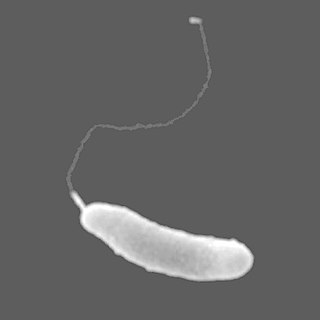Related Research Articles

Sinorhizobium/Ensifer is a genus of nitrogen-fixing bacteria (rhizobia), three of which have been sequenced.
Ancylobacter oerskovii is a Gram-negative, pleomorphic, rod-shaped, non-spore-forming bacteria from the family of Xanthobacteraceae which has been isolated from soil from Mugla in Turkey. Ancylobacter oerskovii has the ability to utilize oxalic acid.
Ancylobacter rudongensis is a bacterium from the family of Xanthobacteraceae which has been isolated from root of the plant Spartina anglica from the beach from the Jiangsu Province in China.
Ancylobacter vacuolatus is a bacterium from the family of Xanthobacteraceae which has been isolated from soil.
Arthrobacter alpinus is a psychrotrophic, Gram-positive and aerobic bacterium species from the genus of Arthrobacter which has been isolated from alpine soil from the Grossglockner area from the mountain range Hohe Tauern, in Austria.
Arthrobacter cryoconiti is a psychrophilic, Gram-positive, aerobic and non-motile bacterium species from the genus of Arthrobacter which has been isolated from cryoconite from the Banker glacier in the Ötztaler Alpen in Austria.
Microvirga guangxiensis is a Gram-negative, rod-shaped, strictly aerobic, non-spore-forming and non-motile bacteria from the genus of Microvirga which has been isolated from soil from a rice field in the Guangxi Province in China.
Chryseobacterium takakiae is a Gram-negative, rod-shaped and non-spore-forming bacteria from the genus of Chryseobacterium which has been isolated from the moss Takakia lepidozioides from the Gawalong glacier in Tibet in China.
Sphingomonas glacialis is a Gram-positive, rod-shaped, psychrophilic and non-motile bacteria from the genus of Sphingomonas which has been isolated from cryoconite from the Stubai Glacier in Tyrol in Austria.
Sphingomonas psychrolutea is a Gram-negative, rod-shaped, aerobic and psychrotolerant bacteria from the genus of Sphingomonas which has been isolated from the Midui glacier in Tibet in China.
Nocardioides psychrotolerans is a Gram-positive, non-spore-forming and rod-shaped bacterium from the genus of Nocardioides which has been isolated from soil from the Hailuogou glacier from Szechuan Province in China.
Nocardioides szechwanensis is a Gram-positive, non-spore-forming and rod-shaped bacterium from the genus of Nocardioides which has been isolated from soil from the Hailuogou glacier from the Szechuan Province in China.

Marinomonas arctica is a Gram-negative, psychrotolerant and motile bacterium from the genus of Marinomonas which has been isolated from sea-ice from the Canadian Basin from the Arctic Ocean.
Salinibacillus is a genus of bacteria from the family of Bacillaceae.
Ornithinimicrobium is a Gram-positive, non-spore-forming and non-motile bacterial genus from the family of Ornithinimicrobiaceae. The genus was formerly in the family Intrasporangiaceae, but later genomic data caused it to be reclassified in 2018.
Dokdonella is a genus of Proteobacteria from the family of Rhodanobacteraceae. Dokdonella is named after the island Dokdo.
Rhodanobacter is a Gram-negative and non-motile genus of Proteobacteria.
Arthrobacter ruber is a Gram-positive bacterium from the genus of Arthrobacter has been isolated from ice from the Midui glacier from Tibet in China.
Cryobacterium aureum is a Gram-positive, psychrophilic and rod-shaped bacterium from the genus Cryobacterium which has been isolated from glacier ice in China.
Agromyces bauzanensis is a Gram-negative and aerobic bacterium from the genus of Agromyces which has been isolated from hydrocarbon-contaminated soil from Bozen in Italy.
References
- 1 2 LPSN lpsn.dsmz.de
- ↑ Straininfo of Ancylobacter polymorphus
- ↑ Deutsche Sammlung von Mikroorganismen und Zellkulturen
- ↑ UniProt
- ↑ Xin, YH; Zhou, YG; Chen, WX (June 2006). "Ancylobacter polymorphus sp. nov. and Ancylobacter vacuolatus sp. nov". International Journal of Systematic and Evolutionary Microbiology. 56 (Pt 6): 1185–8. doi: 10.1099/ijs.0.64118-0 . PMID 16738088.